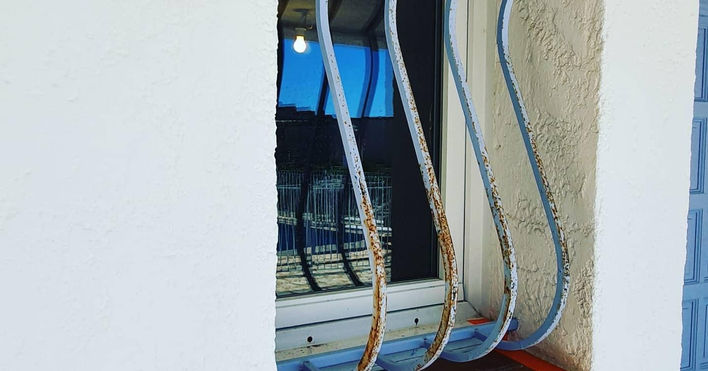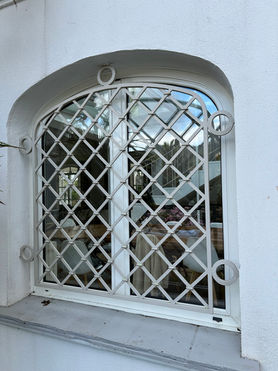
SAINT-TROPEZ
DRAGUIGNAN
SAINT-RAPHAEL
VIDAUBAN
ASF PAINTING & DECORATION

Painting Ironwork
Welcome to our site dedicated to building painter services in the Gulf of St Tropez.
With our expertise and passion for painting and renovation, we offer a complete range of services to enhance and protect your home.
YOUR PROJECT, OUR EXPERTISE
Quick and personalized quote
Why paint ironwork?
Ironwork, often exposed to the elements, requires special attention.
Painting is not only an aesthetic solution, it also plays a key role in protecting metal surfaces.
Here are the main reasons to paint your ironwork:
1. Protection contre la corrosion

Metal is particularly vulnerable to humidity and bad weather, especially in coastal areas such as Saint-Tropez or Ramatuelle, where salty air accelerates the formation of rust.
A quality paint acts as a protective barrier.
Localized example:
A wrought iron gate in Sainte-Maxime has been completely renovated with anti-rust paint and UV-resistant varnish, guaranteeing a longer lifespan.
2. Aesthetics and integration

Well-painted ironwork adds a touch of elegance to a facade or garden.
Thanks to a wide range of colors and finishes (matte, satin, glossy), it is possible to personalize the appearance of your ironwork.
3. Sustainability

Proper painting significantly extends the life of ironwork, reducing long-term maintenance and repair costs.
Steps for painting ironwork
Painting ironwork requires careful preparation and suitable tools.
Here is a step-by-step guide to successfully doing this.
1. Inspection and preparation

Before you begin, inspect the hardware for rusty or damaged areas.
Careful preparation is essential to ensure good paint adhesion.
Preparation sub-steps:
1. Cleaning:
Remove dirt and dust using a wire brush or pressure washer.
2. Degreasing:
Use a degreasing product to remove traces of oil or grease.
3. Sanding:
Sand surfaces to smooth imperfections and improve paint adhesion.
Practical tip:
If the surface is very rusty, consider sandblasting for a deeper clean.
2. Application of an anti-rust treatment

To protect your ironwork for a long time, apply an anti-corrosion primer before painting.
This product prevents the appearance of rust and improves the resistance of the paint.
Localized example:
In Draguignan, a wrought iron balustrade was treated with a zinc-based primer, followed by a glycerophthalic paint for a smooth and durable finish.
3. Applying the paint

Choosing the right paint is essential to ensure an aesthetic and durable result.
Here are the types of paint suitable for ironwork:
• Glycero paint:
Durable and shiny, ideal for areas exposed to the elements.
• Epoxy paint:
Offering excellent resistance to impact and abrasion.
• Polyurethane paint: Recommended for marine environments.
Application methods:
• Brush:
Ideal for detailed or hard to reach areas.
• Sprayer:
For quick and even application on large surfaces.
Practical tip:
Apply two coats of paint for better coverage and increased durability.
4. Drying and finishing

Observe the drying times indicated by the manufacturer before exposing the ironwork to the elements.
A layer of protective varnish can be added to enhance UV and humidity resistance.
Tips for maintaining your painted ironwork
Regular maintenance is essential to maintain the appearance and protection of your ironwork.
Here are some practical tips:
1. Regular cleaning:
Remove dust and residue with a damp cloth.
2. Periodic inspections:
Check for cracks or chips in the paint and touch up if necessary.
3. Application of a protective wax:
For added protection against the elements.
FAQ: Your questions about painting ironwork
1. Can I paint directly over a rusty surface?

No. It is essential to remove rust before applying paint.
Use a wire brush or sandblast to clean the surface.
2. What paint should I choose for exterior ironwork exposed to the elements?

Choose a glycero or epoxy paint, specially designed for metal, and apply a protective varnish for better durability.
3. How long does paint last on ironwork?
With proper preparation and regular maintenance, quality paint can last between 5 and 10 years.
Conclusion: Enhance your ironwork with suitable paint

Painting ironwork is a crucial step to ensure its longevity and aesthetics.
By following these tips and using quality products, you will achieve a long-lasting and elegant result.
If you are located in Saint-Tropez, Sainte-Maxime, Draguignan, or the surrounding area, call on our experts for complete support
Example of Similar Achievements
• Ironwork and Gilding in Vidauban
→ Example of restoration and gilding on ironwork.
→ Our projects in the Vidauban region.






